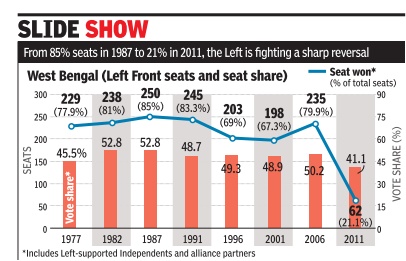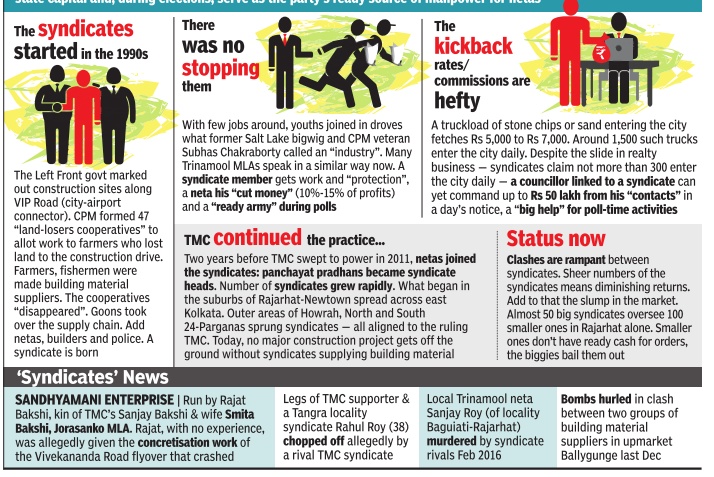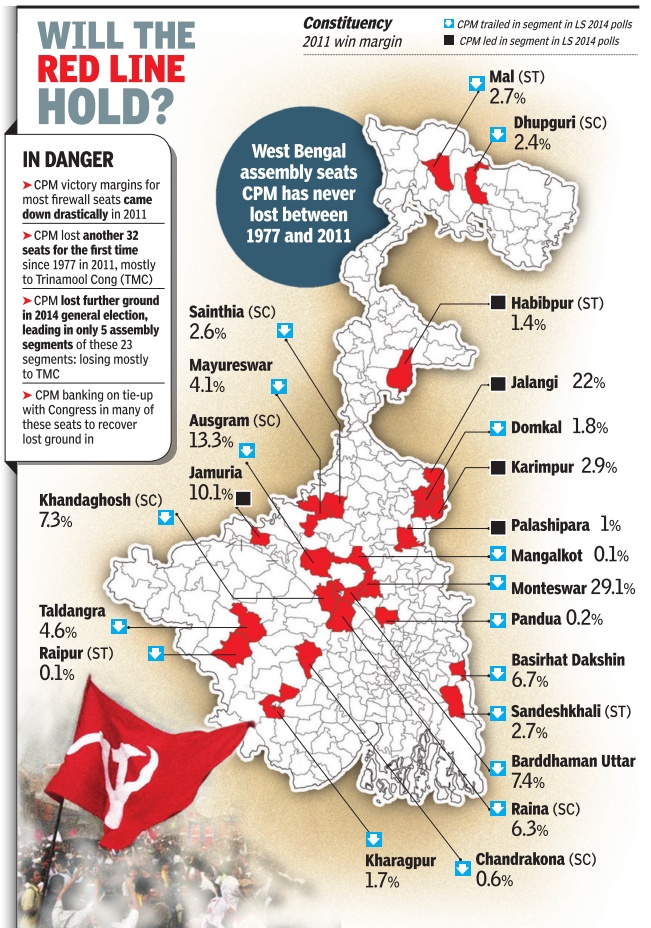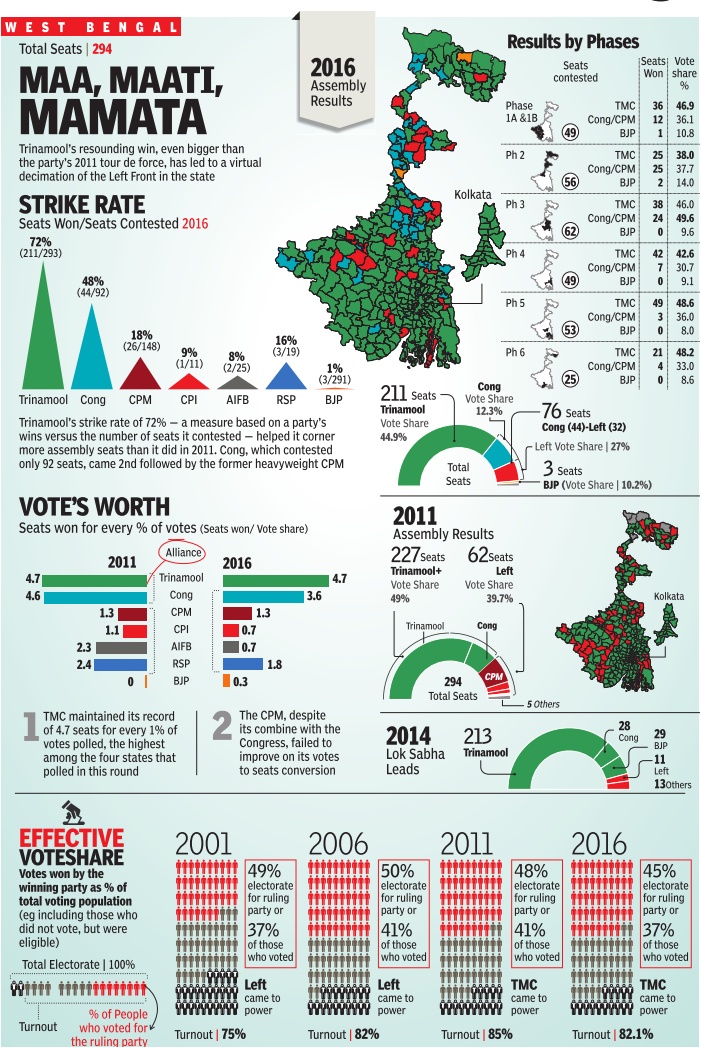West Bengal: Assembly elections
This is a collection of articles archived for the excellence of their content. |
Contents |
1977-2011, seats: RSP and AIFB
See graphic


See graphic


CPM’s 23 ‘safe’ seats
The Times of India, Apr 15 2016

The 23 seats in Bengal CPM's never lost since 1977 hold key to its comeback run
Nalin Mehta
In 2016, as it struggles to regain lost ground in alliance with Congress, the party's real challenge is to hold on to these 23 seats. A TOI analysis shows that in nine south-central districts the CPM appears to be well entrenched. The party's problem, though, is that while in 2011 it held on to these constituencies in the face of a TMC tsunami, its victory margins were drastically down to under 10% in one-third of these 23 seats.
Before 2011, delimitation changed the contours of these constituencies, and CPM barely scraped through in most of them.
Things got worse in the 2014 LS polls.The party had leads in only 5 of these 23 assembly se g ments. While BJP won a lifetime high of 16.8% vote share in that elec tion, it was the TMC that beat the Left in these seg ments. Even more worrying was the TMC's high leads in these areas: In many cases more than 20,000 votes. These losses partly explain why the CPM went ahead with a seats deal with the Congress, which retains small pockets of influence, like in Malda and Murshidabad.
As CPM state secretary and party's chief ministerial candidate, Surjya Kanta Mishra has argued the alliance happened “spontaneously“ and the “initiative came from us“. For the Left Front, whose vote share in Bengal fell from 48.4% in 2006 to 39.1% in 2011, Bengal 2016 is crucial for its survival.
Looking at the geographical spread of the CPM wall, what stands out is its spread from Jalpaiguri (2 seats) in the north to Barddhaman (7 seats) in central Bengal to Pashchim Medinipur (2 seats) and North 24-Paraganas (2 seats) in the south.
Along with another 32 assembly seats it lost for the first time since 1977 in 2011, these 23 remain pivotal for the Left's fortunes and it is banking on them to recover lost ground.
Results, assembly elections
2016
Overview
See graphic



Congress improves
The Times of India, May 20 2016
Cong holds its ground, is main oppn in assembly
Mamata Banerjee may call Congress a “mere signboard“, but she will have to concede her allyturned-rival the opposition status in Bengal assembly . Congress has survived Trinamool's tsunami and not only added two seats to take its tally to 44, but also increased its vote share from 9.6% to 12%. “We will be the main opposition in the Bengal assembly after 15 years,“ Manas Bhuniya, one of the last Congress functionaries to join the jote, said after a thumping win from Sabang.
But the biggest challenge for PCC president Adhir Chowdhury will be to retain the opposition seat count.“The two parties are ideologically similar. If offered olive branches, the MLAs will be only too keen to join Trinamool, like they did after Tri namool and Congress annulled their alliance in September 2012,“ psephologist Biswanath Chakraborty said.
Congress' fortunes have been slipping ever since its chief minister, Siddharth Shankar Ray , lost in 1977. But things turned worse after 2011, with Trinamool repeatedly poaching its workers and Congress legislators switch ing allegiance and cross-voting in the Rajya Sabha polls.
To stop a repeat of the 15th assembly , Congress must keep its MLAs politically engaged. A functionary at Bidhan Bhavan admitted as much: “We are waiting for the state chief 's signal to form a roadmap for anti-Trinamool agitation programmes for next year's panchayat polls.“
CPM/ Left becomes no.3
The Times of India, May 20 2016
Five years after 2011 when it was voted out of power, the Left Front lost its main Opposition status in the 2016 assembly polls. There are clear indications that the Left--particularly CPM--has suffered a massive slide, a trend that began with the 2008 panchayat polls.
The Left is now relegated to third place after the Congress, its jote (coalition) partner.
Knives are out for CPM state secretary Surjya Kanta Mishra for entering into a “suicidal jote“ with Congress.Since a substantial section of the CPM was averse to the alliance, unpleasant questions are sure to come up in the CPM state committee meeting on Saturday .
Provisional vote share figures bear out the Left Front's downward spiral from 40.42% in the 2011 assembly polls--which it lost very badly--to 29% in the 2014 Lok Sabha polls, and now a mere 25.8% in the 2016 assembly polls. Its seat share has increased slightly from 27% in the assembly segment-wise results in 2014, but this is far less than Congress' performance as jote partner. CPM leader Mohammed Salim said that a section of Congress voters didn't vote for Left candidates.“It appears that people did not accept this jote,“ the CPM MP acknowledged. In perhaps the most stun ning blow, CPM state secretary Surjya Kanta Mishra--one of the driving forces of the jote--lost in his home turf of Narayangarh. Only a handful of winners--such as Sujan Chakrabarty , Asoke Bhattacharya, Tanmoy Bhattacharya--survived to defend the Left in the assembly .
Kolkata: 31|34 for TMC, with reduced margins
The Times of India, May 20 2016
The Trinamool Congress virtually swept through Kolkata and its suburbs. Of the 34 seats in Kolkata and urban belts of North 24-Parganas, South 24Parganas and Howrah, the party won all but three seats.
However, the dominance of TMC -it won all 11 Kolkata urban assembly seats -was tempered by a slide in the victory margin in a many seats, including that of CM Mamata Banerjee. Mamata retained Bhowanipur, that she had won by 54,000 votes in 2011, by a margin of around 25,000 votes -a reduction of nearly 50%. Ministers like Amit Mitra, Subrata Mukherjee, Sashi Panja, Javed Khan, Partha Chatterjee, Bratya Basu and Sadhan Pande saw fat victory margins turn slim as did mayor Sovon Chatterjee.
The slide in victory margins also reflected the dis quiet among a section of urban voters over issues like corruption and syndicate raj. When asked about the Saradha scam and Narada sting, Mamata said, “There's no corruption in Trinamoool.“ The issue certainly did not make any dent in the party's tally. But Madan Mitra, who had the dubious distinction of becoming the first candidate in Bengal to contest the polls from behind bars, lost. In Jorasanko, where the Vivekananda flyover collapse became a major talking point, Smita Baksi did win but her margin was pared by 25,000 votes.
Candidates who figured in the Narada sting did win, but the victories were far from convincing. In Ballygunge, Subrata Mukherjee's margin was down by 26,000 votes. Mayor Sovon Chatterjee, who had a margin of 48,173 votes in 2011, has won by 16,658 votes this time. Partha Chatterjee, whose image took a beating over allegations over his PhD, saw the winning margin for the Behala West seat crash by 50,000 votes. The syndicate effect appeared to have played its part, reducing the victory margins of canddates in the northern belt.